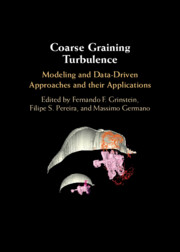Book contents
- Frontmatter
- Contents
- Contributors
- Prologue
- Part I Paradigms and Tools
- 1 Numerical Simulations and Coarse-Graining
- 2 An Overview of Scale-Resolving Simulation Models for Practical Flows
- 3 Filtering Approaches and Coarse Graining
- 4 Filtered Density Function
- 5 Symmetries, Subgrid-Scale Modeling, and Coarse Graining
- 6 Coarse-Graining Turbulence Using the Mori–Zwanzig Formalism
- 7 Data-Driven Modeling for Coarse Graining
- 8 Verification, Validation, Uncertainty Quantification, and Coarse-Graining
- Part II Challenges
- Epilogue
- Abbreviations
- Index
- References
4 - Filtered Density Function
A Stochastic Closure for Coarse-Grained Simulation
from Part I - Paradigms and Tools
Published online by Cambridge University Press: 31 January 2025
- Frontmatter
- Contents
- Contributors
- Prologue
- Part I Paradigms and Tools
- 1 Numerical Simulations and Coarse-Graining
- 2 An Overview of Scale-Resolving Simulation Models for Practical Flows
- 3 Filtering Approaches and Coarse Graining
- 4 Filtered Density Function
- 5 Symmetries, Subgrid-Scale Modeling, and Coarse Graining
- 6 Coarse-Graining Turbulence Using the Mori–Zwanzig Formalism
- 7 Data-Driven Modeling for Coarse Graining
- 8 Verification, Validation, Uncertainty Quantification, and Coarse-Graining
- Part II Challenges
- Epilogue
- Abbreviations
- Index
- References
Summary
An overview is presented of the filtered density function (FDF) methodology as a closure for large eddy simulation (LES) of turbulent reacting flows. The theoretical basis and the solution strategy of LES/FDF are briefly discussed, with the focus on some of the closure issues. Some of the recent applications of LES/FDF are reviewed, along with some speculations about future prospects for such simulations.
Information
- Type
- Chapter
- Information
- Coarse Graining TurbulenceModeling and Data-Driven Approaches and their Applications, pp. 127 - 150Publisher: Cambridge University PressPrint publication year: 2025
References
Accessibility standard: Unknown
Why this information is here
This section outlines the accessibility features of this content - including support for screen readers, full keyboard navigation and high-contrast display options. This may not be relevant for you.Accessibility Information
- 2
- Cited by
